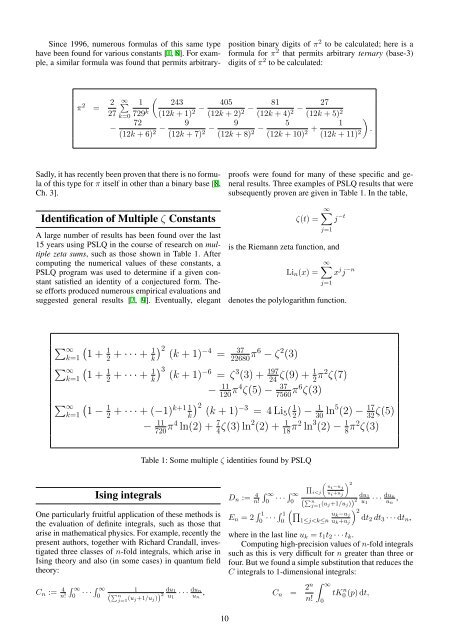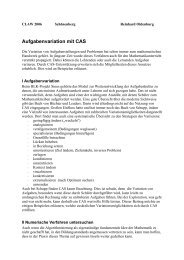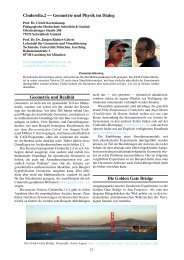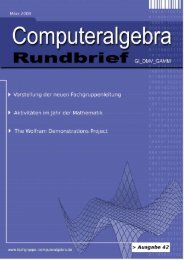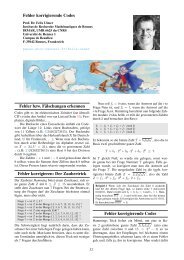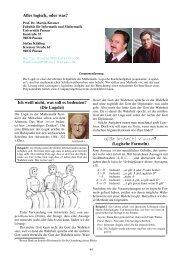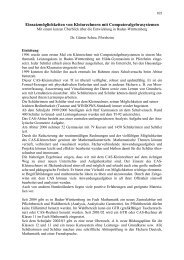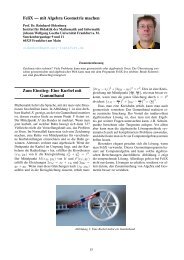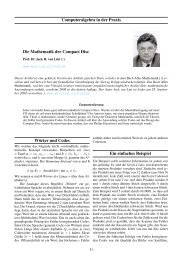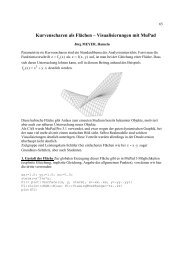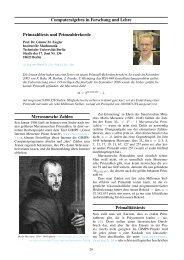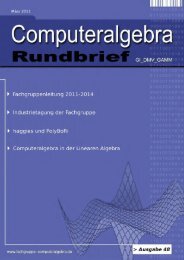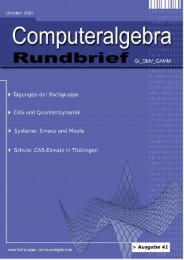Mathematica - Fachgruppe Computeralgebra
Mathematica - Fachgruppe Computeralgebra
Mathematica - Fachgruppe Computeralgebra
Erfolgreiche ePaper selbst erstellen
Machen Sie aus Ihren PDF Publikationen ein blätterbares Flipbook mit unserer einzigartigen Google optimierten e-Paper Software.
Since 1996, numerous formulas of this same type<br />
have been found for various constants [1, 8]. For example,<br />
a similar formula was found that permits arbitrary-<br />
position binary digits of π 2 to be calculated; here is a<br />
formula for π 2 that permits arbitrary ternary (base-3)<br />
digits of π 2 to be calculated:<br />
π2 = 2 ∞ 1<br />
27 k=0 729k <br />
243 405 81 27<br />
−<br />
−<br />
−<br />
(12k + 1) 2 (12k + 2) 2 (12k + 4) 2 (12k + 5) 2<br />
72<br />
9<br />
9<br />
5<br />
1<br />
−<br />
−<br />
−<br />
−<br />
+<br />
(12k + 6) 2 (12k + 7) 2 (12k + 8) 2 (12k + 10) 2 (12k + 11) 2<br />
<br />
.<br />
Sadly, it has recently been proven that there is no formula<br />
of this type for π itself in other than a binary base [8,<br />
Ch. 3].<br />
Identification of Multiple ζ Constants<br />
A large number of results has been found over the last<br />
15 years using PSLQ in the course of research on multiple<br />
zeta sums, such as those shown in Table 1. After<br />
computing the numerical values of these constants, a<br />
PSLQ program was used to determine if a given constant<br />
satisfied an identity of a conjectured form. These<br />
efforts produced numerous empirical evaluations and<br />
suggested general results [2, 9]. Eventually, elegant<br />
∞ k=1<br />
∞ k=1<br />
proofs were found for many of these specific and general<br />
results. Three examples of PSLQ results that were<br />
subsequently proven are given in Table 1. In the table,<br />
ζ(t) =<br />
∞<br />
j −t<br />
j=1<br />
is the Riemann zeta function, and<br />
Lin(x) =<br />
∞<br />
j=1<br />
x j j −n<br />
denotes the polylogarithm function.<br />
<br />
1<br />
1 2 −4 37<br />
1 + 2 + · · · + k (k + 1) = 22680π6 − ζ2 (3)<br />
<br />
1<br />
1 3 −6 3 197 1<br />
1 + 2 + · · · + k (k + 1) = ζ (3) + 24 ζ(9) + 2π2ζ(7) ∞ <br />
1<br />
k=1 1 − 2<br />
+ · · · + (−1)k+1 1<br />
k<br />
Ising integrals<br />
One particularly fruitful application of these methods is<br />
the evaluation of definite integrals, such as those that<br />
arise in mathematical physics. For example, recently the<br />
present authors, together with Richard Crandall, investigated<br />
three classes of n-fold integrals, which arise in<br />
Ising theory and also (in some cases) in quantum field<br />
theory:<br />
Cn := 4<br />
∞<br />
n! 0 · · · ∞<br />
0<br />
− 11<br />
120π4ζ(5) − 37<br />
7560π6ζ(3) 2 −3 (k + 1) = 4 Li5( 1 1<br />
2 ) − 30 ln5 (2) − 17<br />
32ζ(5) − 11<br />
720 π4 ln(2) + 7<br />
4 ζ(3) ln2 (2) + 1<br />
18 π2 ln 3 (2) − 1<br />
8 π2 ζ(3)<br />
Table 1: Some multiple ζ identities found by PSLQ<br />
1<br />
( du1<br />
n<br />
2 u1<br />
j=1 (uj+1/uj))<br />
· · · dun<br />
un ,<br />
10<br />
Dn := 4<br />
∞<br />
n! 0 · · · ∞<br />
0<br />
En = 2 1<br />
0 · · · 1<br />
0<br />
<br />
2 ui−uj i


